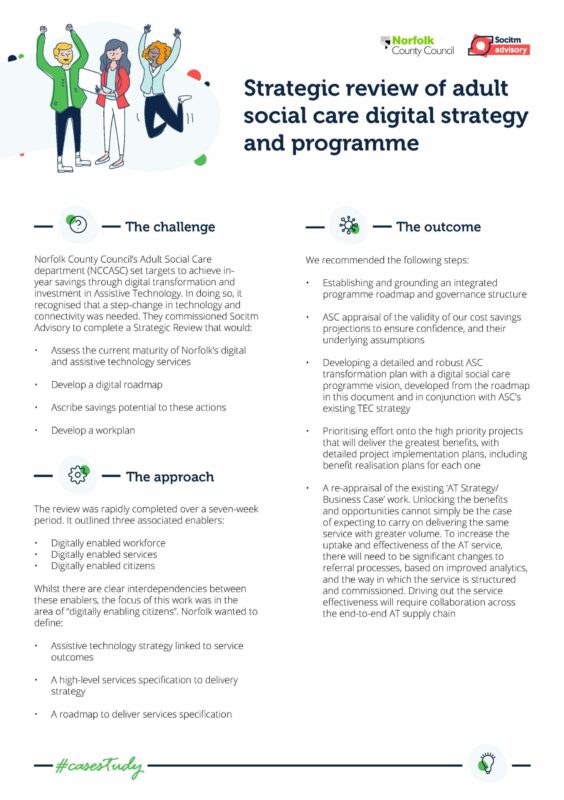The challenge
Norfolk County Council’s Adult Social Care department (NCCASC) set targets to achieve in-year savings through digital transformation and investment in Assistive Technology (AT). In doing so, it recognised that a step-change in technology and connectivity was needed. They commissioned Socitm Advisory to complete a Strategic Review that would:
- Assess the current maturity of Norfolk’s digital and assistive technology services
- Develop a digital roadmap
- Ascribe savings potential to these actions
- Develop a workplan
The approach
The review was rapidly completed over a seven-week period. It outlined three associated enablers:
- Digitally enabled workforce
- Digitally enabled services
- Digitally enabled citizens
Whilst there are clear interdependencies between these enablers, the focus of this work was in the area of “digitally enabling citizens”. Norfolk wanted to define:
- Assistive technology strategy linked to service outcomes
- A high-level services specification to delivery strategy
- A roadmap to deliver services specification
“Technology will be integral to good, quality care. It will enable professionals to work efficiently, for services to work smartly, and for people to live independently at home for longer – reducing the need for formal, intensive adult social care intervention.”
Taken from Norfolk Futures’ summary
The outcome
We recommended the following steps:
Establishing and grounding an integrated programme roadmap and governance structure
- Adult Social Care (ASC) appraisal of the validity of our cost savings projections to ensure confidence, and their underlying assumptions
- Developing a detailed and robust ASC transformation plan with a digital social care programme vision, developed from the roadmap in this document and in conjunction with ASC’s existing TEC strategy
- Prioritising effort onto the high priority projects that will deliver the greatest benefits, with detailed project implementation plans, including benefit realisation plans for each one
- A re-appraisal of the existing ‘AT Strategy/Business Case’ work. Unlocking the benefits and opportunities cannot simply be the case of expecting to carry on delivering the same service with greater volume. To increase the uptake and effectiveness of the AT service, there will need to be significant changes to referral processes, based on improved analytics, and the way in which the service is structured and commissioned. Driving out the service effectiveness will require collaboration across the end-to-end AT supply chain
The options available to them, along with the relative cost savings were fully identified, including:
Initiative 1.1: Flexible and mobile working enabled
The Liquidlogic mobile application enables the use of restricted case management systems on mobile devices, allowing front-line users to access and update case files irrespective of location.
Benefits include: staff productivity; cost savings (travel and potentially office space)
Potential full-year savings: £1.13m – £2.27m
Initiative 1.3: Exploit Liquidlogic phase 1 capabilities
Optimise use of LAS application, streamlining data capture, integrating with the CRM system and digitising time intensive manual transactions.
Benefits include: staff and back office productivity; improved data quality
Potential full-year savings: £478k – £915k
Initiative 2.2: Marketplace and eBrokerage
Development of marketplace for reliable availability and to directly connect buyers and providers. Support of real-time tendering.
Benefits include: market efficiency; commissioning intelligence
Potential full-year savings: £700k – £1.4m
Initiative 2.3: Provider contract management
Streamlined reimbursement to care providers.
Benefits include: improved management and control over spend; productivity
Potential full-year savings: £210k – 340k
Initiative 3.1: Smarter AT enabled through analytics
Increased, higher quality AT referrals driven through analytics and a systematic culture change. Coupled with optimised and cost-effective AT delivery.
Benefits include: cost avoidance and savings
Potential full-year savings: £840k – £1.68m
